mountain bike for kids
The Ultimate Guide to Choosing the Perfect Mountain Bike for Kids
Mountain biking is an exhilarating outdoor activity that fosters a love for adventure, fitness, and nature among young riders. If you're considering introducing your child to this thrilling sport, selecting the right mountain bike is of utmost importance. A well-suited mountain bike not only promotes safety and comfort but also enhances the riding experience, making it more enjoyable. In this article, we will explore key factors to consider when choosing a mountain bike for kids, ensuring they have the best possible start in their biking journey.
Understanding the Basics of Mountain Bikes for Kids
Mountain bikes designed for kids come in various sizes, styles, and specifications tailored to their unique height, weight, and riding abilities. Unlike adult mountain bikes, children's models typically emphasize lightweight materials, ease of handling, and durability to withstand rough terrain. It's essential to choose a bike that fits your child's body well, as this will significantly influence their confidence and performance on the trails.
Key Factors to Consider
1. Size Matters The first step in choosing a mountain bike for kids is ensuring it’s the right size. Mountain bikes are usually categorized by wheel size. For younger children, 16-inch to 20-inch wheels are ideal, while older kids and teens may benefit from 24-inch to 26-inch wheels. Most manufacturers provide size charts to help find the perfect fit. Additionally, when seated on the bike, your child should be able to touch the ground with their feet for better balance and control.
2. Frame Material The weight of the bike is crucial for young riders. Most kids' mountain bikes feature aluminum frames, which offer a blend of lightweight construction and durability. Steel frames are sturdier but heavier, posing a challenge for younger riders. Make sure to choose a frame that minimizes weight without sacrificing strength.
3. Gearing Options When it comes to gearing, consider your child's riding skills and the terrain they will encounter. For beginners, a single-speed bike can be easier to manage, while those who are more experienced or tackling varied terrains might benefit from a bike with multiple gears. Keep in mind that gears can complicate things for younger riders, so assess your child's proficiency before making a decision.
mountain bike for kids

4. Suspension Types Mountain bikes come with different types of suspension. Hardtail bikes have a suspension on the front only, providing a smoother ride over bumps while maintaining efficiency on flat trails. Full-suspension bikes absorb shocks from both the front and rear, making them great for rough terrains but heavier and more costly. For most kids just starting out, a hardtail bike is often sufficient.
5. Brakes Safety is paramount, and effective braking systems are crucial for a child's bike. Rim brakes are common in lower-end models, offering adequate stopping power. However, disc brakes are becoming popular due to their superior stopping ability, especially in wet conditions. Ensure the brakes are easy to operate and require minimal hand strength, allowing younger riders to stop safely and efficiently.
6. Accessories and Customization After settling on a bike, consider adding accessories for safety and convenience. Helmets are a must, along with knee and elbow pads. More experienced young riders may also want to add items like a water bottle holder or bike lights. Customizing the bike with colorful stickers or grips can also make it more appealing to kids, fostering a sense of ownership and excitement.
Involve Your Child in the Decision-Making Process
The process of selecting a mountain bike can be an enjoyable experience for both you and your child. Be sure to involve them in the decision-making process, letting them test ride different models and express their preferences. This engagement not only fosters excitement about biking but also helps them develop ownership of their new passion.
Conclusion
Choosing the perfect mountain bike for kids involves careful consideration of size, weight, gearing options, suspension, and brakes. By prioritizing safety, comfort, and the right fit, you can set your child up for countless adventures on the trails. With the right bike, your child will embark on a journey filled with exploration, physical activity, and unforgettable memories in the great outdoors. Mountain biking is more than just a sport—it's a gateway to a lifelong love of adventure and nature.
-
The Perfect Baby TricycleNewsAug.11,2025
-
Ride into Fun with Bikes for KidsNewsAug.11,2025
-
Ride into Adventure with the Perfect Kids Balance BikeNewsAug.11,2025
-
Fun and Safe Riding with the Best Childrens ScootersNewsAug.11,2025
-
Find the Perfect Childrens Bike for Your Little OneNewsAug.11,2025
-
Explore the Best Baby Tricycles for Your Little OneNewsAug.11,2025
-
Three-Wheel Light-Up Scooter Benefits for KidsNewsJul.11,2025








